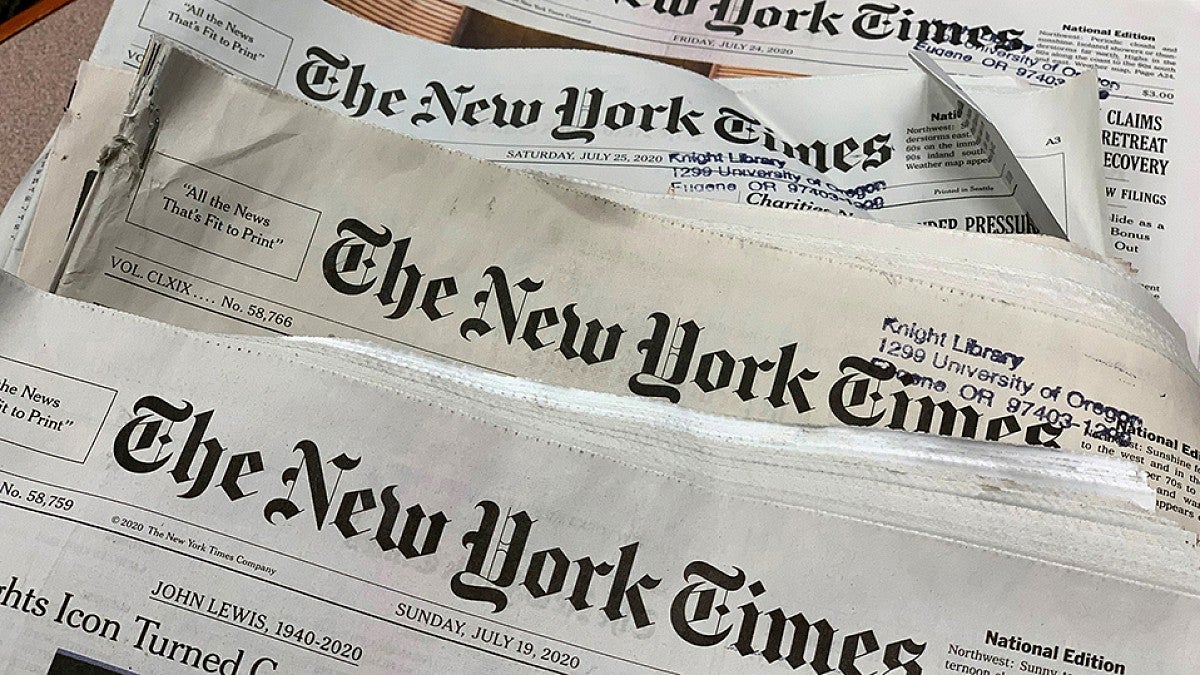
What makes The New York Times so iconic? Founded in 1851, The New York Times has grown into a global powerhouse in journalism. Known as "The Gray Lady," this newspaper has a storied history of shaping public opinion and reporting on significant events. From its fearless coverage of Tammany Hall's corruption to publishing the Pentagon Papers, The Times has consistently pushed the boundaries of investigative journalism. With over 120 Pulitzer Prizes, it stands as a beacon of journalistic excellence. Whether through its print edition or its expansive digital presence, The New York Times continues to set the standard for news reporting worldwide.
Key Takeaways:
- The New York Times, also known as "The Gray Lady," has a rich history dating back over 170 years, marked by courageous reporting, technological advancements, and significant societal impacts.
- From its founding in 1851 to its modern reach and influence, The New York Times has consistently prioritized journalistic integrity, won numerous awards, and embraced technological innovations to shape the media industry.
The Origins of The New York Times
The New York Times, often called "The Gray Lady," has a storied history that dates back over 170 years. Let's dive into its beginnings and early milestones.
- Founding: Established in 1851 by Henry Jarvis Raymond and George Jones, it was originally named the New-York Daily Times.
- Initial Success: It quickly gained traction among conservative readers, earning praise from Horace Greeley, the publisher of the New-York Tribune.
- Name Change: In 1869, George Jones took over and renamed it The New-York Times.
- Tammany Hall Coverage: The paper's critical articles on Tammany Hall's William M. Tweed led to his imprisonment in 1873.
- Penny Paper: Initially sold for a penny, it aimed to avoid sensationalism and report news objectively.
The Ochs Era and Transformation
Adolph Ochs' acquisition of The Times marked a significant turning point, transforming it into a globally respected publication.
- Adolph Ochs: In 1896, Adolph Simon Ochs bought The Times, elevating its status.
- Editorial Excellence: Ochs emphasized thorough reporting, excellent international coverage, and removed fiction from its pages.
- Titanic Coverage: The 1912 coverage of the Titanic's sinking significantly boosted its prestige.
- World War Coverage: The Times enhanced its reputation with comprehensive coverage during both World Wars.
- Pentagon Papers: In 1971, it published reports based on the Pentagon Papers, leading to a landmark Supreme Court case protecting press freedom.
Awards and Recognition
The New York Times has been recognized for its journalistic excellence with numerous awards and accolades.
- Pulitzer Prizes: By the early 21st century, it had won over 120 Pulitzers, the most of any news organization.
- Ochs-Sulzberger Family: Since 1896, the Ochs-Sulzberger family has chaired The Times, with A. G. Sulzberger currently serving as chairman and publisher.
- National Edition: In the 1970s, it introduced a national edition transmitted by satellite to regional printing plants.
- Online Edition: Launched in 1995, it began employing color photography in its print edition in 1997.
- Subscription Service: Introduced in 2005, TimesSelect charged for access to portions of its online edition but was discontinued two years later.
Technological Advancements
The Times has consistently leveraged technology to expand its reach and improve its reporting capabilities.
- Electronic Version: In 2006, it launched The Times Reader, allowing subscribers to download the current print edition.
- New York Times Building: Relocated to the newly constructed New York Times Building in Manhattan in 2007.
- Digital Subscription Plan: Instituted in 2011, it limited free access to content.
- Journalistic Excellence: The Times deploys journalists worldwide to witness history unfold, often at personal risk.
- Impact on Society: Fearless journalism holds power to account and spurs change, improving lives through in-depth reporting.
Historical Reporting and Innovations
The Times has a rich history of reporting on significant events and embracing technological innovations.
- Historical Reporting: During the American Civil War, correspondents gathered information directly from Confederate states.
- Automated Printing Presses: Implemented in 1962, this move led to fears over technological unemployment and a strike by the New York Typographical Union.
- Strike and Its Aftermath: The strike left New York with only three remaining newspapers: The Times, the Daily News, and the New York Post.
- Editorial Board Establishment: Adolph Ochs established the editorial board in 1896, setting a new standard for editorial excellence.
- Slogan Competition: In 1896, a competition for a new slogan led to "All the World’s News, but Not a School for Scandal," though it ultimately stuck with "All the News That’s Fit to Print".
Modern Features and Fun Facts
The Times has evolved with the times, adding new features and embracing modern trends.
- Website Slogan Contest: In the 1990s, a competition for a website slogan generated over 8,000 entries.
- Color Printing: One of the last US newspapers to start printing in color, beginning with the Book Review section in 1993.
- Historical Preservation: Reporters are given resources to dig into single stories for months, highlighting a commitment to in-depth reporting.
- Shark Sightings: In 2021, it reported that more than 20 species of sharks live in the waters off New York and New Jersey.
- Crossword Puzzle: Initially condemned as "a familiar form of madness," it later became a beloved feature.
Courageous Reporting and Impact
The Times has a legacy of courageous reporting that has led to significant societal impacts.
- Henry Raymond's Gatling Guns: During a violent protest in 1851, Henry Raymond installed two Gatling guns on top of his headquarters to deter protesters.
- Tammany Hall Accounting Books: In 1871, it published Tammany Hall's accounting books, exposing corruption and leading to William M. Tweed's imprisonment.
- International Recognition: By the early 20th century, it had gained international recognition for high-quality journalism.
- Technological Advancements: Consistently leveraged technology to expand circulation and improve reporting capabilities.
- Pulitzer Prize Wins: Numerous Pulitzer Prizes for investigative reporting, feature writing, and editorial excellence.
Legal Battles and Integrity
The Times has been involved in landmark legal battles and has consistently prioritized journalistic integrity.
- New York Times Co. v. Sullivan: In 1964, it was involved in a landmark Supreme Court case that restricted the ability of public officials to sue the media for defamation.
- Journalistic Integrity: Consistently prioritized integrity, often taking risks to report on sensitive or controversial topics.
- Historical Milestones: Covered many historical milestones, including the sinking of the Titanic, both World Wars, and significant social movements like the Civil Rights Movement.
- Editorial Board Changes: Significant changes in its editorial board over the years, with notable editors like Carr Van Anda contributing to its growth.
- Expansion into Europe: In the 1930s, it began expanding coverage into Europe under Arthur Hays Sulzberger's leadership.
Modern Reach and Influence
The Times continues to be a leading publication with a broad reach and significant influence.
- Newspaper of Record: Serves as one of the country's newspapers of record, providing comprehensive coverage of domestic, national, and international news.
- Print Circulation: As of 2023, it is the second-largest newspaper by print circulation in the United States, with 296,330 print subscribers.
- Online Subscribers: Has 8.83 million online subscribers, the most of any newspaper in the United States.
- Historical Preservation Efforts: Significant efforts to preserve historical archives, making much content available to the public through digital platforms.
- Investigative Reporting: Renowned for investigative reporting, leading to numerous exposés and reforms over the years.
Diverse Content and Societal Impact
The Times offers a wide range of content and has had a significant impact on society.
- Opinion Pieces: Publishes a wide range of opinion pieces, from editorials to op-eds, providing diverse perspectives on current events and issues.
- Reviews and Features: In addition to news coverage, it publishes reviews and features on various topics, including books, arts, and culture.
- Impact on Society: Through its reporting, it has influenced public opinion and policy decisions, leading to reforms and changes in various fields.
- Technological Innovations: At the forefront of technological innovations in the media industry, from automated printing presses to the launch of its online edition.
- Legacy and Influence: Its legacy and influence extend beyond its own pages, setting a standard for journalistic excellence and inspiring other publications.
The Legacy of The New York Times
The New York Times stands as a pillar of journalistic excellence. Founded in 1851, it has grown from a penny paper to a global news powerhouse. Its fearless reporting, from the Pentagon Papers to the coverage of the Titanic, has shaped public opinion and held power to account. With over 120 Pulitzer Prizes, the Times' commitment to quality journalism is undeniable. The Ochs-Sulzberger family has guided it for over a century, ensuring its legacy endures. Technological advancements, like the digital edition and automated printing presses, have kept it relevant in a changing media landscape. With nearly 9 million online subscribers, its influence continues to grow. The New York Times isn't just a newspaper; it's an institution that has profoundly impacted society and will likely continue to do so for generations.
Frequently Asked Questions
Was this page helpful?
Our commitment to delivering trustworthy and engaging content is at the heart of what we do. Each fact on our site is contributed by real users like you, bringing a wealth of diverse insights and information. To ensure the highest standards of accuracy and reliability, our dedicated editors meticulously review each submission. This process guarantees that the facts we share are not only fascinating but also credible. Trust in our commitment to quality and authenticity as you explore and learn with us.


